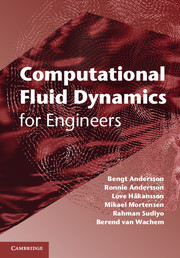5 - Turbulent mixing and chemical reactions
Published online by Cambridge University Press: 05 January 2012
Summary
The purpose of this chapter is to give an introduction to problems faced by engineers wanting to use CFD for detailed modelling of turbulent reactive flows. After reading this chapter you should be able to describe the physical process of turbulent mixing and know why this can have an effect on the outcome of chemical reactions, e.g. combustion. The problem arises when the grid and time resolution is not sufficient to resolve the concentration and the average concentration in the cells is a poor estimation of the actual concentration as shown in Figure 5.1. The local concentration changes fast, and we need models that can predict the space- and time-average reaction rate in each computational cell.
The average concentration in a computational cell can be used to describe macromixing (large-scale mixing) in the reactor and is relatively straightforward to model. The concentration fluctuations, on the other hand, can be used to describe micromixing (small-scale mixing on the molecular level). To quantify micromixing, the variance of the concentration fluctuations is used. Chemical reactions can take place only at the smallest scales of the flow, after micromixing has occurred, because reactions occur only as molecules meet and interact. An expression for the instantaneous rate of chemical reactions is often known for homogeneous mixtures. However, the average rate of chemical reactions in a reactor subject to mixing will depend also on the rate of micromixing.
- Type
- Chapter
- Information
- Computational Fluid Dynamics for Engineers , pp. 113 - 142Publisher: Cambridge University PressPrint publication year: 2011
- 1
- Cited by



